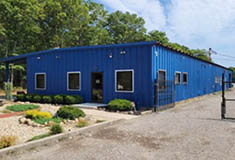Building and maintaining sustainable communities: The short and long-term impacts of our actions - by Erik Heuler
 H2M-240x300.jpg" alt="Erik Heuler,H2M architects + engineers" width="240" height="300" /> Erik Heuler,H2M architects + engineers
H2M-240x300.jpg" alt="Erik Heuler,H2M architects + engineers" width="240" height="300" /> Erik Heuler,H2M architects + engineersWe are all part of, participate in and serve as the foundation of the communities we live in. The decisions we make, the policies we adopt and the actions we take all have an impact on our communities and those around us. If we want to move towards more sustainable communities we must consider what that impact (from our decisions, policies, and actions) will be and if those outcomes are desired.
One of the most commonly sighted definitions of sustainability comes from the UN Brundtland Commission Report of 1987 which states sustainability is meeting the “needs of the present without compromising the ability of future generations to meet their own needs.” Stephen Wheeler simplified the definition, stating “sustainability...improves the long-term health of human and ecological systems.” Further, sustainability has been defined as meeting the triple bottom line, equally considering economic, social and environmental factors.
A sustainable community, one that meets the “needs of the present” while “improving...long-term health,” would provide everyone with not only their most basic needs of sustenance and safety, but also meaningful employment, fulfilling recreation, freedom, a fair and equitable justice system, and the freedom of self-expression and self-actualization along with the opportunity to thrive. All of this must be achieved by allowing “future generations to meet their own needs,” improving “the long-term health of...ecological systems,” and meeting the triple bottom line.
In building sustainable communities, we must consider the short and long-term impacts of our actions. The “seven generations,” a concept attributed to Native American communities, is an approach that considers how the actions of today will affect the next seven generations. When thinking in terms of 140 years, one could imagine a change in the decision making process. This type of analysis is becoming easier with the access we have to information and advanced software which helps us to ensure we are making informed decisions and are learning from past successes and failures.
To start, we need to accomplish the first part of the Brundtland commission definition of meeting the “needs of the present.” There is no way we can know how to accomplish this for future generations if we aren’t able to meet our current needs. We need to identify where and why people aren’t meeting their current needs in order to design solutions. Partnering with local businesses and governments can help in developing new practices and policies to ensure everyone’s needs are met. Taking small steps is a good start to move communities closer to their goals, however large structural changes are needed in many cases which can be difficult.
Applying lessons that have stood the test of time is likely to be beneficial to the long-term health of all. We should be using the environment to our advantage and nature as a guide when designing and building our communities. Nature offers millions of years of research and is solving some of the same problems with which we struggle. Likewise, we should be designing our buildings and communities along with nature, taking advantage of its available heating, cooling and lighting when possible. If we analyze how nature designs structures, we can relearn some lessons we’ve lost throughout the years.
Charrettes must be organized to include community leaders in active, decision-making roles when planning our communities. Community groups are often given a token role with no real power, a mistake that risks failing to meet the community’s needs. Communities know what they need most and to not use this knowledge is a missed opportunity. In order to create sustainable communities we need to maximize the use of renewable resources while offering a variety of employment, housing, recreation and transportation options. Improving efficiency is a good step, but only allows us to extend our non-renewable resources long enough to identify suitable renewable replacements.
Sustainable communities cannot live in isolation or as an island in a sea of unsustainability. We must continue to work within our communities, learn from the successes of others, and share the things that are moving us towards true sustainability for the global community. Sustainability is not something we do to or add onto our communities, it is how they survive and it comes with continuous effort, experience and evaluation. A sustainable community requires the active participation of us all to advocate, live, work and play in a way that improves the quality of life for the future. We should continue to strive to answer the question William McDonough has asked, “How can we love all the children of all species for all time?”
Erik Heuler, R.A., LEED AP BD+C, LEED AP + Homes, is a project architect of H2M architects + engineers, Melville, N.Y.
Suffolk County IDA supports expansion of A&Z Pharmaceuticals


The evolving relationship of environmental consultants and the lending community - by Chuck Merritt
When Environmental Site Assessments (ESA) were first part of commercial real estate risk management, it was the lenders driving this requirement. When a borrower wanted a loan on a property, banks would utilize a list of “Approved Consultants” to order the report on both refinances and purchases.









.jpg)